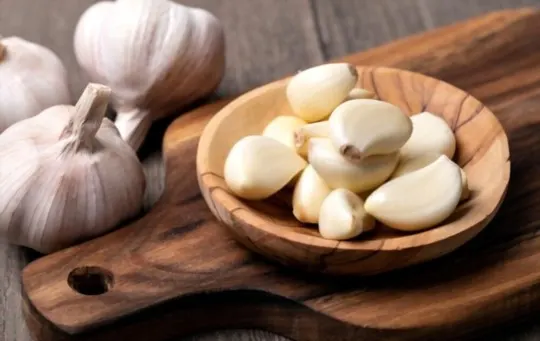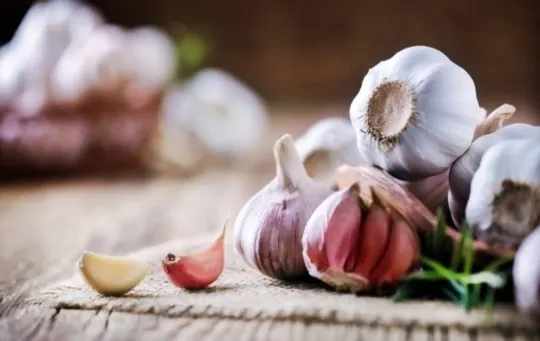It’s a question many of us ask ourselves every time we buy garlic from the store: how long will it last?
Is there really any point in trying to store it for a long period of time, or does garlic just go bad eventually?
The answer is not as simple as you think; depending on what and where you buy your garlic, how you store it, and your desired use-by date — among other factors — the longevity of garlic varies greatly.
In this blog post, I’ll be diving deep into all the secrets behind making sure your garlic has maximum shelf life.
So let’s get started demystifying how exactly to make that head (or bulb) last!
What’s Garlic?

Garlic is a plant in the Allium (onion) family. It is related to onions, shallots, and leeks.
Garlic is native to Central Asia and has been used as a food, spice, and medicine for thousands of years.
It was brought to Europe by the Romans.
Garlic is used around the world in cooking.
It is a key ingredient in many dishes, such as Italian pasta sauce, Chinese stir-fry, and Indian curry.
Garlic can be eaten raw or cooked. It is also used to flavor oils and vinegars.
Garlic has many health benefits.
It is thought to boost the immune system, lower blood pressure, and reduce the risk of heart disease and some cancers.
How Long Does Garlic Last Unrefrigerated?

If you’re like most people, you probably have a few heads of garlic sitting in your pantry.
But how long do they last? And is it safe to keep them unrefrigerated?
Garlic is a versatile and flavorful ingredient that can add a lot to your cooking.
But it doesn’t last forever.
Depending on how it’s stored, garlic can start to sprout roots and develop mold after a few weeks.
And once that happens, it’s no longer safe to eat.
So how can you tell if your garlic has gone bad? The best way is to check the cloves for signs of sprouting or mold.
If they look healthy, then they’re probably still good to eat.
But if they’re starting to sprout or are covered in mold, then it’s time to throw them out.
Generally speaking, garlic will last about a month when stored at room temperature in a dry, dark place.
But if you want to extend its shelf life, you can store it in the fridge where it will last up to two months.
Just be sure to keep it in a sealed container so it doesn’t dry out.
So there you have it.
Now you know how long garlic lasts and how to store it properly.
So go ahead and stock up on this delicious ingredient.
How Long Does Garlic Last In The Fridge?

Garlic is a versatile and flavorful ingredient that can be used in a variety of dishes.
It’s also relatively easy to store.
But how long does garlic last in the fridge?
The answer depends on a few factors, including how it was stored before it was placed in the fridge.
If garlic is stored properly, it can last for several weeks in the fridge.
However, if it isn’t stored properly, it may only last for a few days.
To extend the shelf life of garlic, it’s important to store it in a cool, dry place.
An airtight container is also ideal.
If you’re not sure how long your garlic will last, it’s always best to err on the side of caution and use it sooner rather than later.
So, how long does garlic last in the fridge? With proper storage, it can last for several weeks.
But without proper storage, it may only last for a few days.
How to Tell If Garlic Has Gone Bad?
It’s easy to tell if garlic has gone bad.
Fresh garlic should be firm to the touch and have a bright, white color.
If it’s starting to sprout or the cloves are beginning to brown, that means it’s past its prime and won’t have as much flavor.
If you see any mold growing on the garlic, it’s best to throw it out.
Can You Freeze Garlic?

Yes, you can freeze garlic.
In fact, freezing is one of the best ways to preserve garlic for long-term storage.
When properly stored in the freezer, garlic can last for 10 to 12 months.
To freeze garlic, start by peeling the cloves and slicing them into thin pieces.
Next, spread the garlic slices on a baking sheet and place them in the freezer.
Once frozen, transfer the garlic to an airtight container or freezer bag.
When ready to use, thaw the garlic in the refrigerator and add it to your favorite recipes.
While freezing is an effective way to store garlic, it does have some drawbacks.
Frozen garlic may lose some of its flavor and texture when thawed.
Additionally, thawed garlic will no longer be crisp and will need to be cooked before eating.
For these reasons, it’s best to use frozen garlic in cooked dishes rather than raw preparations.
What are Some Uses for Leftover Garlic?
There are many uses for leftover garlic.
One of the most popular uses is to make garlic bread.
Garlic bread is easy to make and only requires a few ingredients that you likely already have in your kitchen.
Another popular use for leftover garlic is to add it to pasta dishes.
Adding garlic to pasta dishes can really elevate the flavor and make a simple dish more complex and interesting.
Of course, you can always just use leftover garlic in the same dish that you originally used it in.
If you have roasted garlic, for example, you can add it to salads, soups, or other roasted vegetables.
You can also chop up leftover garlic and add it to omelets, frittatas, or quiches.
The possibilities are endless.
So the next time you find yourself with some leftover garlic, don’t throw it out – put it to good use and get creative in the kitchen.
Conclusion
Based on the information in this blog post, garlic can last for quite a long time if stored properly.
Unrefrigerated garlic can last up to two weeks, while garlic stored in the fridge can last up to six months.
You can tell if garlic has gone bad by looking for signs of mold or discoloration.
If you have leftover garlic, you can freeze it for future use.

How Long Does Garlic Last? Does It Go Bad?
Ingredients
- Garlic
- Air-tight containers or Ziplock bags
- Labels and markers
Instructions
- Store your product in an labelled container in a cool, dark place like the pantry or fridge.
- If your food is frozen, allow it to thaw in the fridge before cooking.
- Make sure to look for signs that your food has gone bad before eating it.

Carrie is a food writer and editor with more than 15 years of experience. She has worked for some of the biggest names in the food industry, including Bon Appétit, Food & Wine, and Martha Stewart Living.
As the Editor in Chief of IntroChicago.com, Carrie oversees all of the content on the site. She also manages the team of contributing writers and editors, who help to create delicious recipes, helpful tips, and informative articles that you’ll find on the site.
A native of the Chicago area, Carrie is passionate about all things food. She loves trying new restaurants and experimenting with new recipes in her kitchen. She’s also a graduate of the Culinary Institute of America, so she knows a thing or two about food!
